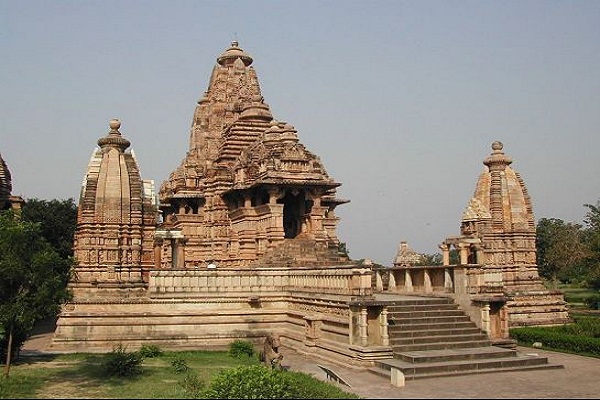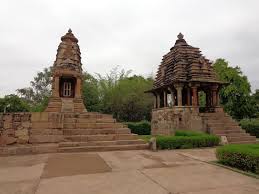The Khajuraho Group of Monuments is a group of Hindu and Jain temples in Chhatarpur, Madhya Pradesh, India, about 175 kilometres (109 mi) southeast of Jhansi. They are one of the UNESCO World Heritage Sites in India. The temples are famous for their nagara-style architectural symbolism and their erotic sculptures. Most Khajuraho temples were built between 950 and 1050 by the Chandela dynasty. Historical records note that the Khajuraho temple site had 85 temples by the 12th century, spread over 20 square kilometers Of these, only about 25 temples have survived, spread over 6 square kilometers. Of the various surviving temples, the Kandariya Mahadeva Temple is decorated with a profusion of sculptures with intricate details, symbolism and expressiveness of ancient Indian art. The Khajuraho group of temples were built together but were dedicated to two religions, Hinduism and Jainism, suggesting a tradition of acceptance and respect for diverse religious views among Hindus and Jains in the region
History –
The Hindu and Jain temple complex at Khajuraho in central India has become a major tourist site for Indians and International tourist. Built nearly a thousand years ago, but abandoned two centuries later, Khajuraho remained a minor pilgrimage site into the present century. The Khajuraho temples include thousands of sexual relief carvings, much publicized throughout India. Khajuraho temples were built during the Chandela period, a dynasty which survived for five centuries before falling to the onslaught of Islam. The history tells us that in the ancient India, the kings did not sponsor directly the making of rock-cut caves, stupas or temples. None of the stupas have sculptures of the Kings and rulers of those times. But with the arrival of the medieval period, rulers began to patronize personally the making of temples.
Places To Visit In Khajuraho –
Kandariya Mahadev Temple- Kandariya Mahadev Temple This is without any doubt the largest and most magnificent temple in Khajuraho. The elegant proportions of this building and its sculptural detailing are the most refined examples of this artistice heritage of central India. Kandariya Mahadev shares its high platform with the small Mahadev shrine and the medium – sized Devi jagdambi Temple, thereby accentuating its height and grandeur. As far as we know, after the Kandariya Mahaddev temple, the artist of khajuraho never again attempted to build a strcuture so high or ornate. The temple measures about 30 metres in lenght and 20 m width. The temple shikhara rises 35.3 metres in length.
Lakshmana Temple –
Lakshmana temple, dedicated to Lord Vishnu, was built from 930-950 AD during the reign of King Yasovarman of the Chandella kingdom. It houses a sacred image of Vaikuntha-Vishnu brought from Tibet. Though the temple is one of the oldest in the Khajuraho fields, it is also one of the most exquistely decorated, covered almost completely with images of over 600 gods in the Hindu Pantheon. The main shrine of the temple, which faces east, is flanked by four freestanding subsidiary shrines at the corners of the temple platform. The temple is famous for the explicitely sexual carvings on the southern side of the temple (images 12-13), though these make up only a small fraction of the total.

Matangeshwar Temple –
Matangeshwar Temple is a ninth century temple and a famous temple in Madhya Pradesh. Chandra Dev of the Chandela dynasty built the temple. The king was a devotee of lord Shiva. Lord Shiva is considered as the venerated sage Matang and that’s how the name of the Shiva Lingam was Matangeswarar. The Matangeshwar Temple is a larger-scale version of the Brahma Temple in terms of plan and design. It has a square plan. Also known as Mrityunjaya Mahadeo Temple, the exterior and interior of this temple is not decorated with sculptures like other Khajuraho Temples but the ceiling is overlapped with sculptures. There is an open air archaeological museum to the south of the temple that has a vast collection of statues and friezes.
Adinath Temple –
The Adinatha Temple, standing immediately to the north of the Parsvanath, is an important constituent of the Jain group of Khajuraho temples. It is a temple without ambulatory, of which only the sanctum and vestibule have survived with their roofs. Its ‘mandapa’ and entrance porch are lost and replaced by a modern entrance chamber, made of lime-plastered masonry, showing arched doorways, which is quite incongruous with the original structure. The temple is ‘sapta-ratha’ on plan as well as in elevation with mono-spired ‘sikhara’ of graceful outline. In the elegance of sculptural style as well as in general plan and design, this temple , dedicated to first Jain Tirthankara, Adinath, bears the closest kinship to the Vamana Temple.
Although there are so many places to visit in khajuraho and for that you need to book a tour from the tour operator who have the knowledge about the khajuraho. we are the leading tour operator company with high class service. book a tour with us and visit khajuraho and the other part of india.
Khajuraho Tour Packages
Golden Triangle Tour With Varanasi Khajuraho
